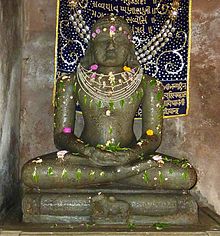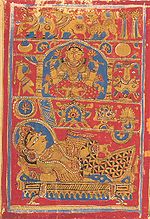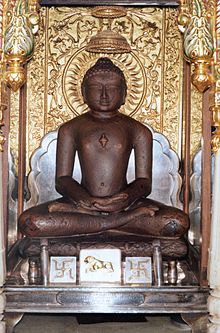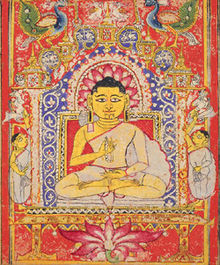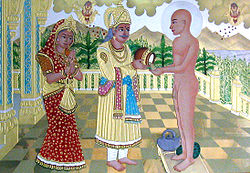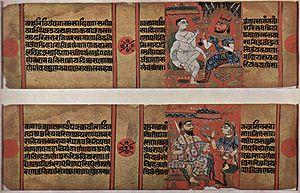- Mahavira
-
This article is about the Tirthankara of Jainism. For the Jain mathematician, see Mahāvīra (mathematician).
Mahāvīra 24th Jain Tirthankara 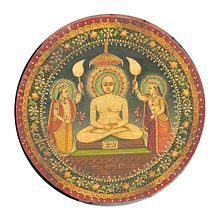
Miniature painting of MahāvīraDetails Alternate names: Vardhamana,Sanmatinayak,Vir,Maha-ativeer, Shramana, Niggantha Historical date: 599–527 BCE Family Father: Siddaratha Mother: Trishala (Priyakarni) Dynasty: Ikshvaku Places Birth: Kundalagrama near Vaishali Nirvana: Pavapuri, District Nalanda, Bihar Attributes Colour: Yellow Symbol: Lion Height: 6 Feet Age At Death: 72 years old Attendant Gods Yaksha: Matang Yaksini: Siddhayika Mahāvīra (Sanskrit: महावीर "Great Hero", Kannada: ಮಹಾವೀರ Mahāvīra, Malayalam: മഹാവീരൻ Mahāvīran and Tamil: அருகன் Arukaṉ) is the name most commonly used to refer to the Indian sage Vardhamāna (Sanskrit: वर्धमान; traditionally 599–527 BCE[1]) who established what are today considered to be the central tenets of Jainism. According to Jain tradition, he was the 24th and the last Tirthankara. In Tamil, he is referred to as Arukaṉ or Arukadevan. He is also known in texts as Vira or Viraprabhu, Sanmati, Ativira,and Gnatputra. In the Buddhist Pali Canon, he is referred to as Nigantha Nātaputta.
Contents
Life
Birth of Prince Vardhaman
In a place called Kundalagrama (Vaishali district) situated close to Besadha Patti, 27 miles from Patna in modern day Bihar, India, Mahavira was born to King Siddartha and Queen Trishala on the 13th day under the rising moon of Chaitra (12 April according to the Gregorian calendar). While still in his mother's womb it is believed he brought wealth and prosperity to the entire kingdom,[2] which is why he was named Vardhaman. An increase of all good things, like the abundant bloom of beautiful flowers, was noticed in the kingdom after his conception. Trishala had a number of auspicious dreams before giving birth to Vardhaman (14 according to the Svetambaras and 16 according to the Digambaras), signs foretelling the advent of a great soul.
Jain tradition states that after his birth, the king of the gods, Indra, bathed him in celestial milk with rituals befitting a future Tirthankara and he was returned to his mother.
Vardhaman's birthday is celebrated as Mahavir Jayanti, the most important religious holiday of Jains around the world.
Early years
As King Siddartha's son, he lived as a prince. However, even at that tender age he exhibited a virtuous nature. He started engaging in meditation and immersed himself in self-contemplation. He was interested in the core beliefs of Jainism and began to distance himself from worldly matters.
Spiritual pursuit
At the age of thirty Mahavira renounced his kingdom and family, gave up his worldly possessions, and spent twelve years as an ascetic. During these twelve years he spent most of his time meditating. He gave utmost regard to other living beings, including humans, animals and plants, and avoided harming them. He had given up all worldly possessions including his clothes, and lived an extremely austere life. He exhibited exemplary control over his senses while enduring the penance during these years. His courage and bravery earned him the name Mahavira. These were the golden years of his spiritual journey at the end of which he achieved arihant status.
Ascetic practices
The Jain text of Kalpasutra describes Mahavira's asceticism in detail, from whom most of the ascetic practices are derived:[3]
The Venerable Ascetic Mahavira for a year and a month wore clothes; after that time he walked about naked, and accepted the alms in the hollow of his hand. For more than twelve years the Venerable Ascetic Mahivira neglected his body and abandoned the care of it; he with equanimity bore, underwent, and suffered all pleasant or unpleasant occurrences arising from divine powers, men, or animals.—Kalpa Sutra 117Henceforth the Venerable Ascetic Mahavira was houseless, circumspect in his walking, circumspect in his speaking, circumspect in his begging, circumspect in his accepting (anything), in the carrying of his outfit and drinking vessel; circumspect in evacuating excrements, urine, saliva, mucus, and uncleanliness of the body; circumspect in his thoughts, circumspect in his words, circumspect in his acts; guarding his thoughts, guarding his words, guarding his acts, guarding his senses, guarding his chastity; without wrath, without pride, without deceit, without greed; calm, tranquil, composed, liberated, free from temptations, without egoism, without property; he had cut off all earthly ties, and was not stained by any worldliness: as water does not adhere to a copper vessel, or collyrium to mother of pearl (so sins found no place in him); his course was unobstructed like that of Life; like the firmament he wanted no support; like the wind he knew no obstacles; his heart was pure like the water (of rivers or tanks) in autumn; nothing could soil him like the leaf of a lotus; his senses were well protected like those of a tortoise; he was single and alone like the horn of a rhinoceros; he was free like a bird; he was always waking like the fabulous bird Bharundal, valorous like an elephant, strong like a bull, difficult to attack like a lion, steady and firm like Mount Mandara, deep like the ocean, mild like the moon, refulgent like the sun, pure like excellent gold'; like the earth he patiently bore everything; like a well-kindled fire he shone in his splendour.—Kalpa Sutra 118Later years
Mahavira devoted the rest of his life to preaching the eternal truth of spiritual freedom to people around India. He traveled barefoot and without clothes, enduring harshest of climates, meeting people from all walks of life who came to listen to his message. At one point Mahavira had over 37,000,000 followers. Mahavira's preaching and efforts to explain Jain philosophy is considered the real catalyst to the spread of this ancient religion throughout India.
At the age of 72 years and 4 and a half months, he attained nirvana in the area known as Pava on the last day of the Indian and Jain calendars, Diwali. Jains celebrate this as the day he attained liberation or moksa. Jains believe Mahavira lived from 599–527 BCE, though some scholars prefer 549–477 BCE.[4]
Previous births
Mahavira’s previous births are discussed in many Jain texts like Trisastisalakapurusa Charitra and Uttarapurana. While a soul undergoes countless reincarnations in transmigratory cycle of samsara, the births of a Tirthankara are reckoned from the time he secures samyaktva or Tirthankar-nam-and-gotra-karma. Jain texts discuss 26 births of Mahavira prior to his incarnation as a Tirthankara.[5] They are:[6]
- Nayasara – A village headman who secured or partial enlightenment in this birth on account of preaching of true dharma by Jain monks.[clarification needed]
- Demi-god in First Saudharma (Name of Heaven as per Jain cosmology)
- Prince Marichi – Grandson of Rsabha, the first Tirthankara.
- Demi-god in Fifth Brahma (Name of heaven as per Jain cosmology)
- Kaushika – A Brahmin
- Pushyamitra – A Brahmin
- Demi-god in First Saudharma
- Agnidyota – A Brahmin
- Demi-god in Second Ishana (Name of heaven as per Jain cosmology)
- Agnibhuti – A Brahmin
- Demi-god in Third Saudharma
- Bharadwaja – A Brahmin
- Demi-god in Fourth Mahendra (Name of Heaven as per Jain cosmology)
- Sthavira – A Brahmin
- Demi-god in Fifth Brahma
- Prince Vishvabhuti
- Demi-god in Seventh Mahashukra (Name of heaven as per Jain cosmology)
- Triprishtha Vasudeva – First Vasudeva of this half-time-cycle
- Naraka in the seventh hell
- A lion
- Naraka in the fourth hell
- A human being (Name unknown)
- Priyamitra – A Chakvartin (The universal ruler of seven continents)
- Demi-god in Seventh Mahashukra (Name of heaven as per Jain cosmology)
- Prince Nandana – Accepted the vow of self control and gained Tirthankara nama karma.
- Demi-god in tenth Pranata (Name of heaven as per Jain cosmology)
- Vardhamana Mahavira (The final birth)
Philosophy
Mahavira's philosophy has eight cardinal principals – three metaphysical and five ethical. The objective is to elevate the quality of life.
Mahavira preached that from eternity, every living being (soul) is in bondage to karmic atoms accumulated by good or bad deeds. In a state of karmic delusion, the individual seeks temporary and illusory pleasure in material possessions, which are the root causes of self-centered violent thoughts and deeds as well as anger, hatred, greed, and other vices. These result in further accumulation of karma.
To liberate one's self, Mahavira taught the necessity of right faith (samyak-darshana), right knowledge (samyak-gyana), and right conduct (samyak-charitra'). At the heart of right conduct for Jains lie the five great vows:
- Nonviolence (Ahimsa) – to cause no harm to any living being;
- Truthfulness (Satya) – to speak the harmless truth only;
- Non-stealing (Asteya) – to take nothing not properly given;
- Chastity (Brahmacharya) – to indulge in no sensual pleasure;
- Non-possession/Non-attachment (Aparigraha) – to detach completely from people, places, and material things.
These vows cannot be fully implemented without accepting the philosophy of non-absolutism (anekantavada) and the theory of relativity (syādvāda, also translated "qualified prediction"). Monks and nuns adhere strictly to these vows, while the laypeople observe them as best they can.
Mahavira taught that men and women are spiritual equals and that both may renounce the world in search of moksha or ultimate happiness.
Mahavira attracted people from all walks of life, rich and poor, men and women, touchable and untouchable. He organized his followers into a fourfold order; monk (sādhu), nun (sādhvī), layman (Śrāvaka), and laywoman (Śrāvikā). This order is known as Chaturvidh Jain Sangha.
Mahavira's sermons were preserved orally by his immediate disciples known as Ganadharas in the Jain Agamas. Through time many Agama Sutras have been lost, destroyed, or modified. About one thousand years after Mahavira's time the Agama Sutras were recorded on palm leaf paper. Svetambaras accept these sutras as authentic teachings while Digambaras use them as a reference.
Jainism existed before Mahavira, and his teachings were based on those of his predecessors. Thus Mahavira was a reformer and propagator of an existing religion, rather than the founder of a new faith. He followed the well established creed of his predecessor Tirthankara Parshva. However, Mahavira did reorganize the philosophical tenets of Jainism to correspond to his times.
A few centuries after Mahavira's Nirvana, the religious order grew more and more complex. There were schisms on minor points, although they did not affect Mahavira's original doctrines. Later generations saw the introduction of rituals and complexities that some criticize as placing Mahavira and other Tirthankaras on the throne similar to those of Hindu deities.
Texts
There are various Jain texts describing the life of Lord Mahavira. The most notable of them is Kalpasutra by Acharya Bhadrabahu I. The first Sanskrit biography of Mahavira was Vardhamacharitra by Asaga in 853 CE[7]
Quotes
- "Once when he sat [in meditation]... they cut his flesh... tore his hair... picked him up and... dropped him... the Venerable One bore the pain." (from the Acaranga Sutra)
See also
- Tirthankara
- Jain philosophy
- Jainism
- History of Jainism
- Trishala
Notes
- ^ "Mahavira." Britannica Concise Encyclopedia. Encyclopædia Britannica, Inc., 2006. Answers.com 28 Nov. 2009. http://www.answers.com/topic/mahavira
- ^ Mehta, T. U. (1993). Path of Arhat – A Religious Democracy. 63. Pujya Sohanalala Smaraka Parsvanatha Sodhapitha. http://www.ibiblio.org/jainism/database/BOOK/arhat.doc. Retrieved 11 March 2008.
- ^ Jacobi, Hermann (1884). (ed.) F. Max Müller. ed (in English: translated from Prakrit). The Kalpa Sūtra. Sacred Books of the East vol.22, Part 1. Oxford: The Clarendon Press. ISBN 070071538X. http://www.sacred-texts.com/jai/sbe22/sbe2200.htm. Note: ISBN refers to the UK:Routledge (2001) reprint. URL is the scan version of the original 1884 reprint
- ^ The Perennial Dictionary of World Religions. Keith Crim, editor. Harper & Row Publishers: New York, 1989. 451.
- ^ Glasenapp, Helmuth von; (Tr.) Shridhar B. Shrotri (1999) (in English, translated from German). Jainism: An Indian Religion of Salvation. Delhi: Motilal Banarsidass Publ. ISBN 8120813766. p. 327
- ^ Helen, Johnson (2009) [1931]. Muni Samvegayashvijay Maharaj. ed (in English. Trans. From Prakrit). Trisastiśalākāpurusacaritra of Hemacandra: The Jain Saga. Part 3. Baroda: Oriental Institute. ISBN 978-81-908157-0-3. pp. 318—333
- ^ Jain, Kailash Chand (1991). Lord Mahāvīra and his times, Lala S. L. Jain Research Series. Motilal Banarsidass. p. 59. ISBN 8120808053. http://books.google.co.in/books?id=0UCh7r2TjQIC&pg=PA341&lpg=PA341&dq=asaga+9th+century+poet#v=onepage&q=&f=false.
Further reading
- "Sraman Mahavira" by Acharya Mahapragya
- "Lord Mahavira and his times" by Kailash Chand Jain (1991) Motilal Banarsidass Publishers PVT LTD Delhi (India)
- "Lord Mahavira (A study in historical perspective)" by Bool Chand ( 1987 ) P.V. Research Institute I.T.I Road Varanasi 5 (India)
- "Lord Mahavira in the eyes of foreigners" by Akshaya Kumar Jain ( 1975 ) Meena Bharati New Delhi 110003 (India)vaibhav singh 8th
External links
- http://www.cs.colostate.edu/~malaiya/mahavira.html
- Shri Mahavir Swami Jain temple in Osiya
- Bhagwan Mahavir Swami's Message
Rishabha or Adinath • Ajitnath • Sambhavanath • Abhinandannath • Sumatinath • Padmaprabha • Suparshvanath • Chandraprabha • Pushpadanta • Sheetalnath • Shreyansanath • Vasupujya • Vimalnath • Anantnath • Dharmanath • Shantinath • Kunthunath • Aranath • Mallinath • Munisuvrata • Naminatha • Neminatha • Parshva • MahaviraCategories:- 527 BC deaths
- 599 BC births
- Ascetics
- Founders of religions
- Indian religious leaders
- People from Bihar
- Tirthankars
- Sanskrit words and phrases
- Nonviolence advocates
- Jain pacifists
- Indian Jains
- 6th-century BC philosophers
- Jain deities
Wikimedia Foundation. 2010.

